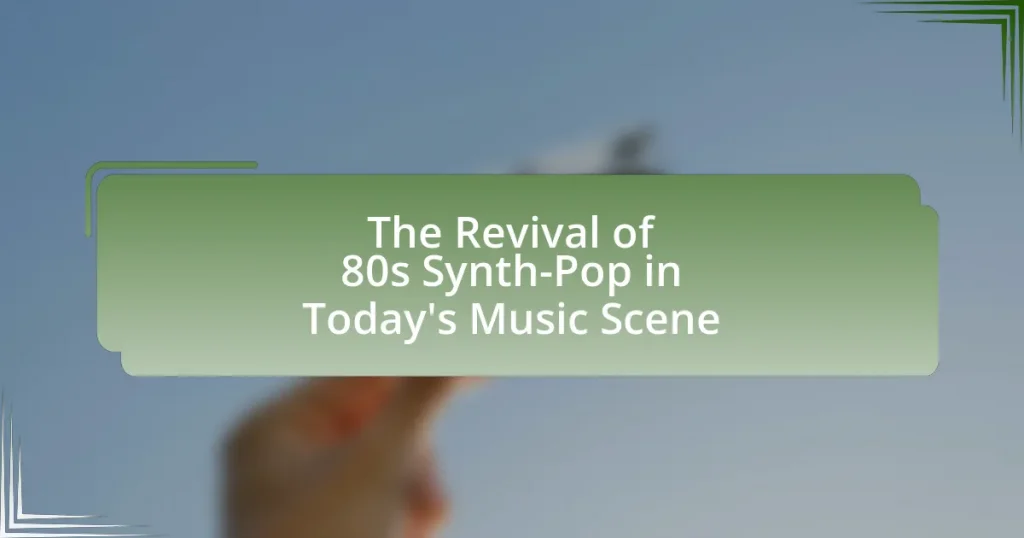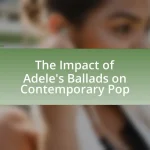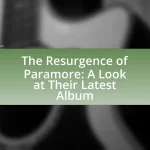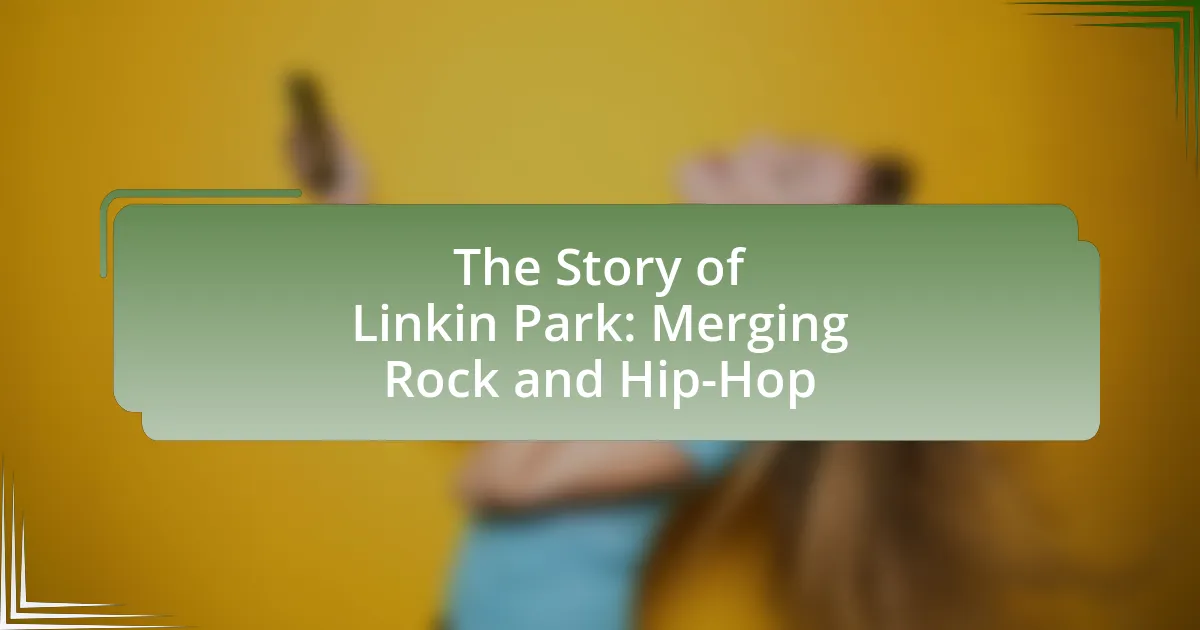The article examines the revival of 80s synth-pop in today’s music scene, highlighting its resurgence through contemporary artists who incorporate vintage synthesizers, catchy melodies, and electronic beats into their work. Key figures such as Dua Lipa and The Weeknd exemplify this trend, blending retro influences with modern production techniques to appeal to both nostalgic listeners and new audiences. The piece also explores the defining characteristics of 80s synth-pop, its influence on contemporary genres, and the cultural factors driving its popularity, including nostalgia and the impact of digital technology. Additionally, it discusses the implications of this revival for the music industry, including production, distribution, and the challenges faced by modern artists in maintaining authenticity while embracing contemporary trends.
What is the Revival of 80s Synth-Pop in Today’s Music Scene?
The revival of 80s synth-pop in today’s music scene refers to the resurgence of musical styles, aesthetics, and production techniques reminiscent of the 1980s synth-pop genre. This revival is characterized by contemporary artists incorporating vintage synthesizers, catchy melodies, and electronic beats into their music, appealing to both nostalgic listeners and new audiences. Notable examples include artists like Dua Lipa and The Weeknd, who have successfully integrated 80s influences into their hits, leading to a broader trend where retro sounds dominate charts. The popularity of playlists featuring 80s synth-pop tracks on streaming platforms further illustrates this revival, with significant streaming numbers indicating a strong listener interest in this genre.
How has 80s Synth-Pop influenced contemporary music genres?
80s Synth-Pop has significantly influenced contemporary music genres by introducing electronic instrumentation and catchy melodies that are now prevalent in pop, indie, and electronic music. Artists like Dua Lipa and The Weeknd incorporate synthesizers and retro production techniques reminiscent of 80s Synth-Pop, which has led to a resurgence of similar sounds in modern tracks. The genre’s emphasis on hooks and danceable rhythms has shaped the structure of current pop songs, as evidenced by chart-topping hits that utilize these elements. Additionally, the aesthetic and thematic elements of 80s Synth-Pop, such as nostalgia and futurism, continue to resonate in contemporary music videos and performances, further solidifying its lasting impact.
What are the defining characteristics of 80s Synth-Pop that are being revived?
The defining characteristics of 80s Synth-Pop that are being revived include catchy melodies, prominent synthesizer use, and a blend of electronic and pop elements. These features are evident in contemporary music, where artists often incorporate vintage synthesizers and drum machines to recreate the distinctive sound of the 1980s. The revival is supported by the resurgence of retro aesthetics in music videos and fashion, reflecting the cultural nostalgia for that era. Additionally, the influence of iconic 80s bands like Depeche Mode and Duran Duran can be seen in modern tracks, showcasing the lasting impact of Synth-Pop on today’s music landscape.
How do modern artists incorporate 80s Synth-Pop elements into their music?
Modern artists incorporate 80s Synth-Pop elements into their music by utilizing vintage synthesizers, catchy melodies, and electronic drum patterns characteristic of that era. For instance, artists like The Weeknd and Dua Lipa have embraced these elements, often using analog synths to create lush soundscapes reminiscent of 80s hits. The resurgence of retro aesthetics in music videos and fashion further reinforces this connection, as seen in The Weeknd’s “Blinding Lights,” which features a synth-driven sound that pays homage to 80s pop. Additionally, the use of production techniques such as reverb and chorus effects mirrors the sonic qualities of classic Synth-Pop tracks, solidifying the genre’s influence in contemporary music.
Why is there a resurgence of interest in 80s Synth-Pop?
The resurgence of interest in 80s Synth-Pop is primarily driven by nostalgia among millennials and Gen Z, who are increasingly drawn to the distinctive sound and aesthetic of that era. This demographic often seeks out music that evokes memories of their childhood or cultural references from popular media, such as films and television shows that feature 80s music. Additionally, the rise of streaming platforms has made it easier for listeners to discover and share classic tracks, leading to a revival in popularity. For instance, artists like The Weeknd and Dua Lipa have incorporated Synth-Pop elements into their music, further popularizing the genre and introducing it to new audiences.
What cultural factors contribute to the revival of 80s Synth-Pop?
The revival of 80s Synth-Pop is primarily driven by nostalgia, the influence of digital technology, and the resurgence of retro aesthetics in contemporary culture. Nostalgia plays a significant role as audiences who grew up during the 1980s seek to reconnect with the music and cultural elements of their youth, leading to a renewed interest in the genre. Digital technology facilitates this revival by enabling artists to easily recreate the iconic sounds of the era, utilizing software and synthesizers that mimic vintage equipment. Additionally, the popularity of retro aesthetics in fashion, film, and art further amplifies the appeal of Synth-Pop, as seen in the success of shows like “Stranger Things,” which prominently features 80s music and style. These cultural factors collectively contribute to the ongoing resurgence of 80s Synth-Pop in today’s music scene.
How does nostalgia play a role in the popularity of 80s Synth-Pop today?
Nostalgia significantly contributes to the popularity of 80s Synth-Pop today by evoking fond memories and emotions associated with that era. This genre, characterized by its catchy melodies and electronic sounds, resonates with listeners who experienced the 1980s, creating a sense of comfort and familiarity. The resurgence of 80s Synth-Pop can be observed in contemporary music, where artists like The Weeknd and Dua Lipa incorporate retro elements, appealing to both older fans and new audiences. Additionally, cultural phenomena such as the Netflix series “Stranger Things,” which heavily features 80s aesthetics and music, further amplify this nostalgic connection, driving interest and engagement with the genre.
Who are the key artists leading the revival of 80s Synth-Pop?
Key artists leading the revival of 80s Synth-Pop include Dua Lipa, The Weeknd, and CHVRCHES. Dua Lipa’s album “Future Nostalgia” features synth-heavy tracks that pay homage to the 80s sound, while The Weeknd’s “After Hours” incorporates retro synth elements, particularly in the hit “Blinding Lights,” which has been widely recognized for its 80s influence. CHVRCHES, known for their electronic pop sound, consistently draws inspiration from 80s synth aesthetics in their music, further solidifying their role in this revival.
What new artists are inspired by 80s Synth-Pop, and how do they pay homage to it?
New artists inspired by 80s Synth-Pop include Dua Lipa, The Weeknd, and CHVRCHES, who pay homage through their use of vintage synthesizers, catchy melodies, and retro aesthetics. Dua Lipa’s album “Future Nostalgia” incorporates synth-driven tracks reminiscent of the 80s sound, while The Weeknd’s “After Hours” features lush synth arrangements and nostalgic themes. CHVRCHES consistently blends modern pop with 80s synth textures, evident in their album “Screen Violence,” which showcases a strong homage to the genre’s iconic sound. These artists effectively revive and reinterpret the essence of 80s Synth-Pop, making it relevant for contemporary audiences.
Which established artists have returned to 80s Synth-Pop sounds in their recent work?
Established artists who have returned to 80s Synth-Pop sounds in their recent work include Depeche Mode, who incorporated vintage synth elements in their album “Memento Mori” released in 2023, and Duran Duran, whose 2021 album “Future Past” features a blend of modern production with classic synth textures reminiscent of their 80s hits. Additionally, The Weeknd has drawn heavily from 80s Synth-Pop influences in his 2020 album “After Hours,” particularly in tracks like “Blinding Lights,” which showcases a retro synth sound that pays homage to the era.
How is the Revival of 80s Synth-Pop manifesting in today’s music scene?
The revival of 80s synth-pop is manifesting in today’s music scene through the resurgence of retro sounds, synthesizer-heavy production, and aesthetic influences in contemporary pop music. Artists like Dua Lipa and The Weeknd have incorporated 80s-inspired synth melodies and drum machines in their hits, exemplified by Dua Lipa’s “Future Nostalgia” and The Weeknd’s “Blinding Lights,” both of which topped charts globally. Additionally, the popularity of synth-pop has led to a resurgence of vintage synthesizers in music production, with sales of classic models like the Roland Juno-106 increasing, reflecting a broader trend of nostalgia-driven music consumption. This revival is further supported by the emergence of new artists who explicitly cite 80s synth-pop as an influence, creating a bridge between past and present musical styles.
What are the most popular songs or albums that exemplify this revival?
The most popular songs and albums that exemplify the revival of 80s synth-pop in today’s music scene include “Blinding Lights” by The Weeknd and the album “Future Nostalgia” by Dua Lipa. “Blinding Lights,” released in 2019, features a retro synth-driven sound reminiscent of 80s hits, achieving significant commercial success by topping charts worldwide. Similarly, Dua Lipa’s “Future Nostalgia,” released in 2020, incorporates vibrant synth-pop elements and has been praised for its nostalgic yet modern approach, solidifying its place in contemporary music. Both works reflect the resurgence of 80s synth-pop aesthetics, evidenced by their widespread acclaim and chart performance.
How do these songs reflect the original 80s Synth-Pop style?
These songs reflect the original 80s Synth-Pop style through their use of synthesizers, catchy melodies, and electronic beats. The prominent use of synthesizers, a hallmark of 80s Synth-Pop, creates a distinct sound characterized by bright, melodic lines and rhythmic bass patterns. Additionally, the songs often feature upbeat tempos and hooks that are designed to be memorable, mirroring the pop sensibilities of artists like Depeche Mode and Duran Duran. The lyrical themes frequently explore love and technology, aligning with the era’s fascination with futurism and romance. This adherence to the sonic and thematic elements of the 80s Synth-Pop genre validates their connection to the original style.
What themes are prevalent in the lyrics of modern Synth-Pop tracks?
Modern Synth-Pop tracks frequently explore themes of nostalgia, love, and technology. Nostalgia is often reflected in lyrics that evoke memories of past experiences, reminiscent of the 1980s aesthetic. Love is portrayed in various forms, including romantic longing and emotional connection, often set against a backdrop of upbeat melodies. Additionally, technology is a central theme, with lyrics addressing the impact of digital life, social media, and artificial intelligence on human relationships. These themes resonate with listeners, as they reflect contemporary societal experiences while drawing inspiration from the genre’s origins.
How are live performances and music festivals embracing 80s Synth-Pop?
Live performances and music festivals are embracing 80s Synth-Pop by incorporating retro aesthetics, synthesizer-heavy lineups, and themed events that celebrate the genre’s iconic sound. Festivals like Coachella and Glastonbury have featured artists influenced by 80s Synth-Pop, such as The Weeknd and Dua Lipa, who often pay homage to the era through their music and visuals. Additionally, dedicated Synth-Pop festivals, such as the “Synthwave Festival,” showcase both established and emerging artists, creating a platform for the genre’s revival. This resurgence is supported by the growing popularity of retro-themed events and the nostalgic appeal of 80s music, evidenced by the increasing number of tribute bands and DJ sets that focus on Synth-Pop classics.
What role do retro-themed events play in promoting 80s Synth-Pop?
Retro-themed events play a crucial role in promoting 80s Synth-Pop by creating immersive experiences that celebrate the genre’s distinctive sound and aesthetic. These events often feature live performances by artists who specialize in Synth-Pop, as well as DJs spinning classic tracks, which helps to introduce the music to new audiences and rekindle nostalgia among fans. For instance, events like “Synthwave Festival” and “Retro Fest” have seen significant attendance, indicating a growing interest in the genre. Additionally, the visual elements, such as neon lights and vintage fashion, enhance the overall atmosphere, reinforcing the cultural significance of 80s Synth-Pop. This combination of music and visual nostalgia effectively engages attendees, fostering a community that supports the revival of the genre in contemporary music.
How do artists recreate the 80s Synth-Pop experience in their live shows?
Artists recreate the 80s Synth-Pop experience in their live shows by utilizing vintage synthesizers, drum machines, and neon visuals that reflect the era’s aesthetic. They often incorporate iconic sounds from instruments like the Roland Juno-106 and the LinnDrum, which were staples in 80s music production. Additionally, performers frequently dress in period-appropriate fashion, such as bright colors and bold patterns, to enhance the nostalgic atmosphere. The use of synchronized light shows and video projections featuring retro imagery further immerses the audience in the 80s vibe, making the experience authentic and engaging. This approach not only appeals to fans of the original genre but also attracts new listeners who appreciate the revival of this distinctive sound and style.
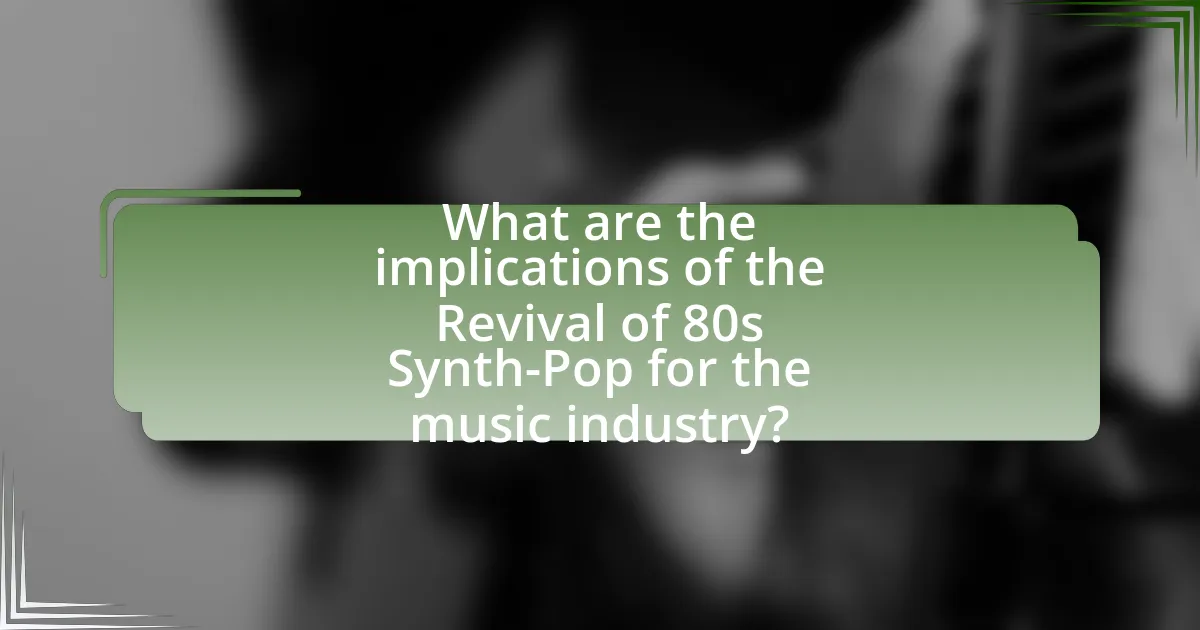
What are the implications of the Revival of 80s Synth-Pop for the music industry?
The revival of 80s synth-pop significantly impacts the music industry by influencing contemporary soundscapes and marketing strategies. This resurgence has led to a renewed interest in synthesizers and electronic production techniques, prompting artists across genres to incorporate retro elements into their music. For instance, the success of artists like Dua Lipa and The Weeknd, who have embraced synth-pop aesthetics, demonstrates a shift in consumer preferences towards nostalgic sounds. Additionally, the revival has spurred a resurgence in vinyl sales and merchandise related to 80s culture, indicating a profitable market for labels and artists. The trend also encourages collaborations between established artists and new acts, fostering innovation while capitalizing on nostalgia.
How does the revival affect music production and distribution?
The revival of 80s synth-pop significantly influences music production and distribution by encouraging the use of vintage synthesizers and production techniques, which enhances the authenticity of contemporary music. This resurgence has led producers to incorporate retro sounds and aesthetics, resulting in a distinct sonic identity that appeals to both nostalgic listeners and new audiences. For instance, artists like The Weeknd and Dua Lipa have successfully integrated synth-pop elements into their music, leading to chart-topping hits and increased streaming numbers. Additionally, the revival has prompted a shift in distribution strategies, with platforms like Bandcamp and SoundCloud enabling independent artists to reach wider audiences without traditional label constraints, thus democratizing access to music production and distribution channels.
What technological advancements are being utilized to recreate 80s Synth-Pop sounds?
Technological advancements such as software synthesizers, digital audio workstations (DAWs), and vintage hardware emulations are being utilized to recreate 80s Synth-Pop sounds. Software synthesizers like Serum and Massive allow musicians to design rich, layered sounds reminiscent of iconic 80s synths. DAWs, such as Ableton Live and Logic Pro, provide extensive tools for arranging and producing music, enabling artists to replicate the production techniques of that era. Additionally, plugins that emulate classic synthesizers, like the Roland Juno-106 and Yamaha DX7, offer authentic sound reproduction, further enhancing the ability to capture the essence of 80s Synth-Pop. These advancements facilitate a modern approach to sound design while honoring the original aesthetic of the genre.
How are record labels responding to the resurgence of 80s Synth-Pop?
Record labels are actively signing new artists and reissuing classic 80s Synth-Pop albums to capitalize on the genre’s resurgence. This trend is evidenced by the increased number of retro-themed music festivals and the success of contemporary artists who incorporate Synth-Pop elements, such as Dua Lipa and The Weeknd. Additionally, labels are investing in marketing strategies that highlight nostalgia, targeting both older fans and new listeners drawn to the distinctive sound of the 80s.
What challenges do modern artists face when reviving 80s Synth-Pop?
Modern artists face several challenges when reviving 80s Synth-Pop, primarily including the saturation of the music market, the need for authenticity, and the integration of contemporary technology. The music industry is flooded with various genres, making it difficult for Synth-Pop to stand out. Additionally, artists must balance nostalgia with innovation, ensuring that their work resonates with both fans of the original genre and new listeners. Furthermore, the use of modern production techniques can sometimes clash with the analog sounds that define 80s Synth-Pop, creating a challenge in maintaining the genre’s signature aesthetic while appealing to current musical trends.
How do artists balance authenticity with contemporary trends?
Artists balance authenticity with contemporary trends by integrating personal style and experiences with current musical influences. For instance, many contemporary synth-pop artists draw inspiration from the 1980s while incorporating modern production techniques and themes relevant to today’s audience. This approach allows them to maintain their unique voice while appealing to current market demands. A notable example is the artist Dua Lipa, who blends retro synth sounds with contemporary pop elements, achieving commercial success while staying true to her artistic identity. This method demonstrates that artists can honor their influences while adapting to the evolving music landscape.
What criticisms do modern Synth-Pop artists encounter regarding their music?
Modern Synth-Pop artists encounter criticisms primarily related to perceived lack of originality and over-reliance on nostalgia. Critics argue that many contemporary Synth-Pop tracks mimic the sound and style of 1980s music without adding innovative elements, leading to claims of being derivative. For instance, some reviewers highlight that the use of vintage synthesizers and production techniques can overshadow artistic growth, resulting in music that feels more like a tribute than a fresh creation. Additionally, there are concerns about the genre’s accessibility, with some listeners perceiving it as overly polished or commercialized, which can detract from the emotional depth often associated with earlier Synth-Pop.
What can aspiring musicians learn from the Revival of 80s Synth-Pop?
Aspiring musicians can learn the importance of blending nostalgia with modern production techniques from the revival of 80s synth-pop. This genre’s resurgence highlights how artists can successfully incorporate retro sounds, such as synthesizers and drum machines, into contemporary music while appealing to both older and younger audiences. For instance, artists like Dua Lipa and The Weeknd have utilized 80s synth elements in their hits, demonstrating that these sounds can create a fresh yet familiar listening experience. The revival also emphasizes the significance of strong melodies and catchy hooks, which were hallmarks of 80s synth-pop, proving that timeless songwriting remains relevant in today’s music landscape.
How can new artists effectively incorporate retro influences into their music?
New artists can effectively incorporate retro influences into their music by studying and integrating the distinctive elements of 80s synth-pop, such as synthesizer melodies, drum machine rhythms, and nostalgic lyrical themes. By analyzing successful 80s synth-pop artists like Depeche Mode and Duran Duran, new musicians can identify key characteristics, including the use of lush synth textures and catchy hooks that defined the genre. Additionally, utilizing modern production techniques while maintaining these retro elements allows for a fresh yet familiar sound, appealing to both new listeners and fans of the original era.
What strategies can musicians use to connect with audiences through nostalgia?
Musicians can connect with audiences through nostalgia by incorporating familiar sounds, themes, and aesthetics from the past, particularly the 1980s synth-pop era. This can be achieved by using vintage synthesizers, drum machines, and production techniques that evoke the sonic characteristics of that time. For example, artists like The Weeknd and Dua Lipa have successfully integrated retro synth sounds into their music, appealing to both older fans who experienced the original era and younger listeners discovering it for the first time. Additionally, visual elements such as album artwork, music videos, and stage designs that reflect 80s culture can enhance the nostalgic experience, reinforcing emotional connections. Research indicates that nostalgia can enhance emotional responses and increase engagement, making it a powerful tool for musicians aiming to resonate with their audience.
